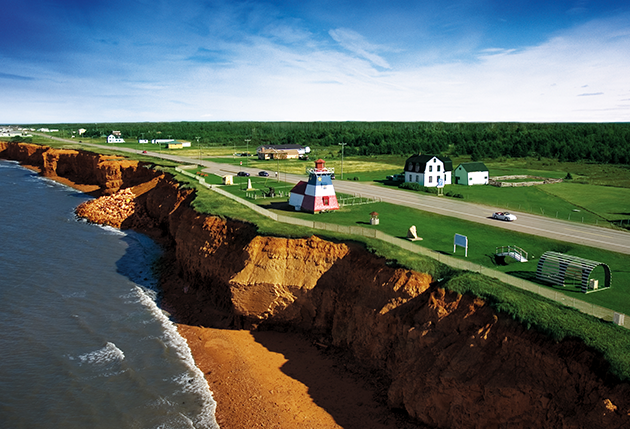
Canada’s Atlantic province of New Brunswick has a rich heritage of Acadian culture, with the largest population of Acadians (descendants of the 17th-century French colonists who settled in the territory of New France) outside Louisiana’s Cajun Country (officially known as Acadiana). If you have two days to explore, take a driving tour of the Acadian Coast, where French is the first language and locals proudly fly the red, white, blue and yellow Acadian flag. The best time to go is during July and August, when the weather is mild and all the attractions are open. On August 15, Canada’s National Acadian Day, join in the Tintamarre, a spirited celebration that draws thousands of revelers to the region.
An Acadian Introduction
Start your explorations in the city of Moncton at the excellent Acadian Museum. Located on the campus of the French-language Université de Moncton, this compact but well-designed museum traces the 400-year history of Canada’s Acadian communities, from the early settlers to contemporary artists and musicians. There’s a detailed exhibition about the devastating “Acadian Expulsion” from 1755 to 1763, when the British military forcibly deported 10,000 Acadians from Atlantic Canada. Among more modern artifacts, you can ogle an actual Oscar, donated by Moncton-area native Paul LeBlanc, who won the 1985 Academy Award for Best Makeup in the film Amadeus.
Music, Theater and Gastronomy
It’s less than an hour’s drive north from Moncton to the town of Bouctouche, where your next stop is Le Pays de la Sagouine. Based on characters created by Acadian author Antonine Maillet, this interactive music and theater experience — which loosely translates as the “Land of the Washerwoman” — is set in a recreated Prohibition-era Acadian fishing village. While many performances are in French, English-speakers should come for Acadian music and for events such as the Saturday afternoon traditional Acadian kitchen party (running through the end of August) that combines toe-tapping tunes with a cooking lesson, where you learn to prepare pets-de-soeurs, the sweet pastry that’s similar to a cinnamon roll.
Beach Walks and Local Memories
As you continue north along the Acadian Coastal Route, a well-marked roadway that meanders through many Acadian communities, take a break on the long sandy beach at Kouchibouguac National Park. It’s worth a look in the visitor center, too, at the compelling “Memories of Our Communities” exhibit that shares recollections of some of the 1,200 Acadian and English-speaking locals whose homes and lands were expropriated to create the national park.
Island Explorations
Overnight in the riverside town of Miramichi, where the Rodd Miramichi River hotel isn’t deluxe, but its fishing lodge-style rooms have lovely views across the Miramichi River. In the morning, learn more about the region’s cultural heritage, which included Acadian, Scottish and Irish settlers, at the Beaubears Island historic site. Costumed guides in the riverfront visitor center and on the wooded island itself depict many of the colorful characters who once inhabited the area. You can even paddle to Beaubears Island in a traditional voyageur canoe.
Wander into the Acadian Past
About 90 minutes north of Miramichi, outside the town of Caraquet, two centuries of Acadian history and culture come to life at the Village Historique Acadien. In more than 30 buildings dating back to the late 1700s up to the mid-1900s, interpreters in period dress (no makeup or modern jewelry allowed) go about their daily business — cooking, blacksmithing, milling, and weaving — as if they were still living in an Acadian community in the era they represent. Come hungry: At La Table des Ancêtres, a restaurant in a traditional Acadian home, you can sample classic Acadian dishes, from the stew-like chicken fricot to poutine râpée, a hearty pork-filled potato dumpling.
Leave Time for Lobster
If you have time before you return south, detour out to the Acadian islands of Lamèque and Miscou. In this lobster-rich area, you can sample your crustaceans fresh off the boat at La Terrasse à Steve, a feet-in-the-sand seafood shack on Miscou Wharf — a luscious lobster-y finish to a couple of quintessential Acadian coast days.
